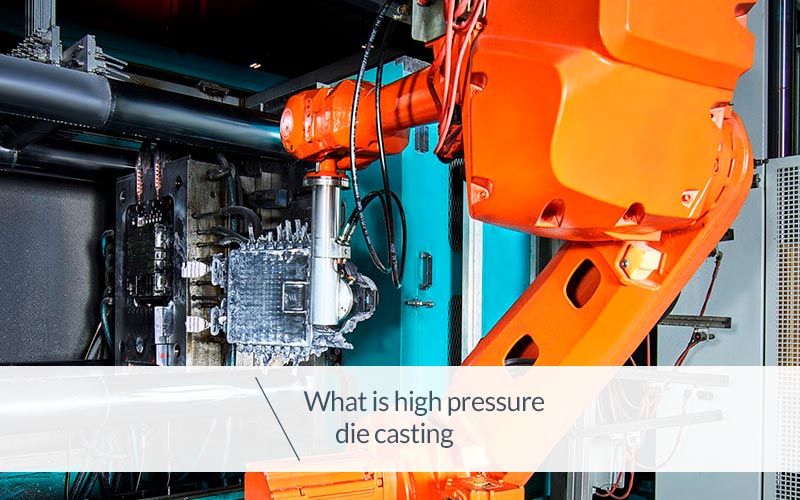
The FAIST Group is specialised in high-pressure die casting.
Due to our extensive experience, close collaboration with our clients, our drive to push past expectations and our hallmark entrepreneurial spirit, we have been able to develop complex solutions to overcome those various limitations normally associated with HPDC.
So just what is this metal-working process?
We are going to explain it right here.
What is high-pressure die casting?
High-pressure die casting is a process wherein molten metal is forced, under pressure, into a sealed mould cavity. It is held in place by a powerful compressive power (true die installed in hydraulics machine) until the metal solidifies.
Following solidification, the die is released, opened and the metal is released.
Following removal, the mould cavity is resealed for the next cycle.
Molten metal injection into the mould cavity occurs in a fraction of a second (usually under 100 ms). One time die cavity is filled, extremely high pressure is applied (often over 1000 bar) into a molten metal true injection plunger. This phase is called intensification.
This pressure compresses out any gases trapped in the metal (during extremely fast and turbulent cavity filling) and feeds more metal into the mould to partially compensate for the shrinkage in the metal whilst it is solidifying.
In addition to traditional high-pressure die casting methods, over recent years there have been a number of improvements in the process. For example:
- vacuum die casting
- semisolid casting
- squeeze casting
High pressure die-casting: hot and cold chamber systems
In order to inject molten metal into the mould, two different systems may be used:
- a hot chamber system
- a cold chamber system
Let’s discover more about these two processes.
The hot chamber system
The hot chamber system is used with metals such as zinc, magnesium and lead.
The injection system for a hot chamber machine is immersed in molten metal from the blast furnace. When the piston pumps, it forces metal along the nozzle and into the die.
The cold chamber system
The cold chamber system is used for metals which melt at high temperatures, such as aluminium, copper and magnesium.
Magnesium parts can be produced by using either systems, although generally speaking small parts are made in hot chamber systems, whilst large parts in cold chamber systems, as hot chamber machines have limited dimensions.
In this system higher pressure is used compared to the hot chamber system. The production rate of a hot chamber machine is higher than that of a cold chamber since less time is required for the pouring process.
The cold chamber system also uses two injections systems in the process:
- horizontal injection
- vertical injections
In this system, the molten metal is poured, either manually or automatically, into an opening leading to a channel feeding the cold chamber.
A piston which is hydraulically activated moves down this steel channel, blocking light and pushing the metal into the mould at high speed and pressure.
Following solidification of the flow, the piston is pulled back, and the mould opened, the flow is expelled and the system is ready to be activated again.
Advantages of high pressure die casting
The advantages of high pressure die casting include higher production speeds when compared to the flow pouring under the effect of gravity.
Furthermore, the ability to produce flows of specific dimensions notably reduces processing operations.
The fusions have a good surface finish, which is a basic requisite for plating, and reduced thickness of the plate walls is made possible by reducing the overall weight of the fusion.
The moulds are durable, thus reducing unit cost prices and more complex parts can be manufactured, thus decreasing the number of components requested each time.
High pressure die casting at FAIST
For some time now FAIST has been specialised in making high-level high pressure die casting processes available, supported by a vastly knowledgeable team and, above all, by leading-edge technology.
This initial step of this process is analysis, above all Fluidodynamics, Thermal and Fem analyses, vital for optimising processes and ensuring the high quality of the item produced. Simulation and virtualisation during the development stage of moulds are also vitally important steps and they are created directly by a FAIST dedicated division.
This high-quality production is possible due to advantages conferred such as the high hygiene alloy process with central and local degassing systems, global process thermal control, temperature and pressure DC tool sensors. Regards equipment FAIST also possess:
- Low oxide dosing system
- Fondarex vacuum system
- High vacuum tool
- Thermal control, units oil, pressurised water, water air, jet cooling
- Additive manufacturing high thermal control tool insert
- Dedicated spraying head
- Semi solid metal GISS device
Semi-solid metal casting
Semi-solid metal casting (SSM) is an extremely high-level process which allows the achievement of excellent results and is suitable for very specific production lines; a prerequisite process for just a few top companies.
In recent years FAIST has implemented this process with success, and has made it available to the telecom and automotive markets.
This process (SMM) is actually a variant of high pressure die casting, and is based on non-ferrous metals (magnesium, copper and aluminium). Effectively it unifies the advantages of both casting and forging. It is named for the fluid property known as thixotropy, which is the effect that allows this process to work. In a simply way, molten metal is stirred and partially solidify (in various fraction solid %) by obtaining globular microstructure (true aluminum dendrite fragmentation). Globular structure improve kinematic viscosity and consequently metal flowability. This pre-solidify preparation, called slurry, is than injected in to the mold cavity like usual HPDC process. Due to thixotropic slurry property is possible fill small part thickness obtaining in some condition better quality, due to less air entrainment during cavity filling and less shrinkage porosity (metal partially solidify). Consequences of previous improvements are increase of alloy conductivity, mechanical property, weldability, heat treatability.



